SFA University
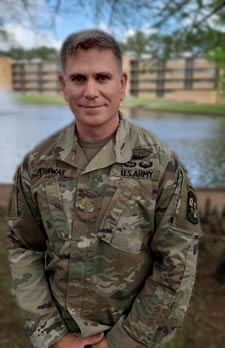 August 24, 2020 — In setting the example of “being the best,” Stephen F. Austin State University Professor of Military Science James Attaway recently was promoted from the rank of major to lieutenant colonel.
August 24, 2020 — In setting the example of “being the best,” Stephen F. Austin State University Professor of Military Science James Attaway recently was promoted from the rank of major to lieutenant colonel.
“Being promoted to lieutenant colonel means a lot to me,” Attaway said. “I started in the Army as a private more than 20 years ago and plan to retire in a few years with my final rank as a lieutenant colonel. It is incredible to think back on all I have experienced.”
Attaway, who graduated from SFA in 2004 with a Bachelor of Science in kinesiology, began his Army career in 1998 when he enlisted as an infantryman. He has since completed training at Ranger, Airborne, and Air Assault schools and more. He has served with numerous units across the world, including Kosovo, Iraq, Korea and Afghanistan.
Attaway was selected as SFA’s chair of military science in 2018. Since then, he has overseen a successful 50-year anniversary for the department, helped establish the 1st Lt. Kile G. West 5K and 10K Memorial Race, and aided the ROTC Ranger Team in winning first place in the Task Force Ranger Challenge for the first time in SFA’s history.
He said he is happy to be “stationed” in Nacogdoches, where he and his family plan to remain after his retirement.
“After 17 years of marriage and 10 moves, it feels really good to be putting down roots,” Attaway said.
Even though his rank has changed, Attaway is still committed to training future Army officers for commissioning.
Despite the challenges brought about by the COVID-19 pandemic, the faculty and staff under Attaway’s leadership have continued to train cadets. Due to safety restrictions, the department is preparing for course modality changes and physical distancing regulations.
“As both Army officers and noncommissioned officers, part of our job is to adapt, overcome and complete missions,” Attaway said. “While COVID-19 has changed how we teach, it hasn’t caused us to stop teaching and mentoring the next generation of Army officers.”
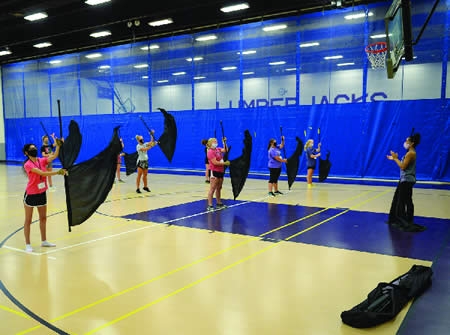
Rehearsals are underway for SFA’s Lumberjack Marching Band color guard and drum line, and band rehearsals get underway when fall classes begin.
August 21, 2020 - As schools and universities carefully crafted their reopening plans amid the coronavirus pandemic, questions about health and safety for students and faculty were at the forefront. Right along with those were questions about sporting events and extracurricular activities.
Although Stephen F. Austin State University currently does not have any home football games scheduled following the Southland Conference’s decision to postpone conference competition for the fall, the athletic department is working to amend that. SFA Athletics Director Ryan Ivey said in a recent press release that SFA will explore avenues for fall competition against other institutions looking to compete.
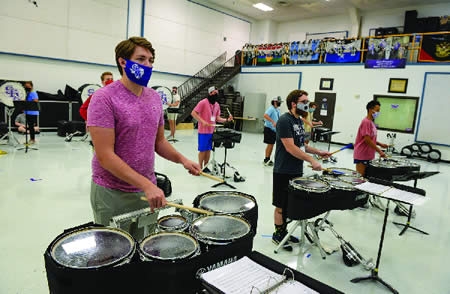
The Lumberjack Marching Band will be ready if and when that happens.
SFA band directors worked throughout the summer on more than designing marching routines; they are fine tuning plans to keep their student musicians safe. Directors opted to split the university band into two separate groups of equal instrumentation to better accommodate social distancing guidelines on the field and in the stands, according to Dr. Tamey Anglley, associate director of bands at SFA and director of the Lumberjack Marching Band.
“We are requiring students to wear face masks anytime they aren’t playing their instruments and brass players to have bell covers for their instruments to help lower the aerosol emission from their bells,” Anglley said.
Additionally, all drills on the field will be at six-step intervals, which means students will be 11.25 feet apart while performing.
As the far-reaching effects of the pandemic began to become more apparent last spring, SFA band directors started researching best COVID-era practices for band instruction and performance. In May, the directors attended a virtual athletic band symposium sponsored by the College Band Directors National Association. The symposium featured presentations from the scientists who were leading the aerosol studies out of University of Colorado and Colorado State University and also clinics from various marching band directors around the country, Anglley explained.
“At that time, no one knew football could or would be canceled or moved to the spring semester,” she said, “so we were mostly discussing the safety measures we needed to take for our students and the many details to think about with social distance protocols. Since then, I have been in communication with our regional CBDNA and Southland Conference athletic band directors where we discuss how everyone is planning this season.”
As a result, fall rehearsal days, performances and game day times for the LMB will be alternated as needed, Anglley explained. If home football games can be scheduled, the band plans to perform, albeit in a limited fashion.
“We went into this season knowing that we wouldn’t be performing at pregame or halftime, but we are still discussing with athletics the possibility of a postgame performance once all football personnel have vacated the field,” Anglley said.
Color guard and drum line camps were conducted this week; leadership camp is Aug. 22; and split-band rehearsals are scheduled during regular class time once the fall semester starts.
For many, performing in the Lumberjack Marching Band is a highlight of the SFA university experience – one that builds memories and fosters friendships that last a lifetime. The 2020 fall LMB season will be like none other before it, and directors are committed to making it memorable and safe.
“The health and safety of the students is our utmost priority at SFA and in the Lumberjack Marching Band,” Anglley said. “We have and will continue to work diligently to provide a safe rehearsal and game day space for our students to have a fulfilling musical experience.”
August 21, 2020 - The Stephen F. Austin State University Rusche College of Business is offering an entrepreneurship major beginning this semester. In response to high demand and the growing need to prepare students with versatile skills that are transferable across many industries, the goal of the program is to equip students with learning tools they can use during times of economic success or in times of uncertainty.
While the entrepreneurship major is a new program, a minor in entrepreneurship has been available and is offered to all SFA students. Dr. Matthew Lindsey, chair of the marketing and management department, believes the entrepreneurship major will be an excellent opportunity for students who have been seeking that degree, while the existing entrepreneurship minor will appeal to a variety of academic disciplines.
“For the past several years, students interested in management and marketing have inquired about two subjects, sports business and entrepreneurship,” Lindsey said. “We are looking forward to fulfilling that demand. I also think the minor is a valuable asset for non-business students across campus who are studying something they love, like music, and want to incorporate that passion into a business. It will equip them with the ability to think through the fundamental business elements needed to produce a viable venture.”
Two new faculty members were hired to help establish the entrepreneurship program: Dr. Raymond Jones, who began in fall 2019, holds a Ph.D. in management with an emphasis on strategy and entrepreneurship; and Dr. Brian Nagy, who earned his Ph.D. in management strategy. He started this semester.
Jones has already taken an active role in the local business community by serving on several panel discussions with the Nacogdoches Economic Development Corporation. He is utilizing those connections to help establish relationships between the university and local businesses.
“The intention of the entrepreneurship program is two-fold: It will prepare our students with a strong skill-set for life after college while serving as a resource for local businesses and start-ups in the community,” Jones said. “Collaboration is important. We are also looking forward to identifying sponsorship opportunities to allow for entrepreneurial competitions on campus.”
Lindsey is optimistic about the program and believes it will be an asset to many students.
“We have a thriving sports business program that was just recently established, and we are excited to be able to launch and grow the entrepreneurship program as well,” he said.
For more information about the Rusche College of Business entrepreneurship minor, contact Dr. Mathew Lindsey at lindseymd@sfasu.edu or (936) 468-1858.
By Richard Massey, senior marketing communications specialist at Stephen F. Austin State University
August 20, 2020 - In celebration of the passage of the 19th Amendment, the bells of Griffith Fine Arts Building on the Stephen F. Austin State University campus will ring 19 times shortly after noon on Wednesday, Aug. 26, to commemorate the U.S. Constitution article that guaranteed women the right to vote.
The 19th Amendment states the right of citizens of the United States to vote shall not be denied or abridged by the United States or by any State on account of sex. It was passed by Congress on June 4, 1919, ratified on Aug. 18 then certified on Aug. 26 of 1920, formally adding it to the U.S. Constitution and providing suffrage to all citizens.
Starting in fall 2018, a group of local interested people – Nineteenth Amendment Celebration, or NAC – began meeting to plan events for 2020 to commemorate the passage of the amendment, according to Dr. Dana Cooper, professor of history at SFA. The onset of COVID-19 changed those plans.
“The Nineteenth Amendment Celebration group had such good intentions for 2020,” Cooper said. Among the events were readings, symposiums, exhibitions, living histories and more.
According to Cooper, the fight for the right to vote was a long struggle that officially began in 1848 with the Seneca Falls convention, which was attended by some 300 men and women. During the conference, Elizabeth Cady Stanton wrote the Declaration of Sentiments, which outlined the rationale for women's suffrage and was based upon the Declaration of Independence. Stanton's document was signed by 100 people, including 68 women and 32 men.
“This is typically considered the formal beginning of the fight for suffrage in the United States,” Cooper said.
Numerous battles ensued in the courts and at the state level, and many women attained suffrage in specific states before the amendment was ratified at the federal level. Texas voted to ratify the 19th Amendment on June 28, 1919, making it the first southern state to do so.
“As one of the original events planned by NAC to commemorate this moment in history, the ringing of the bells on Aug. 26 will honor the long fight – by so many and for so long,” Cooper said. “Different people of different backgrounds, perspectives and races fought for decades to provide equality at the polls and the opportunity to partake in democracy, a process that is arguably more important than ever.”
Plans are underway to move some of the planned commemoration events to Zoom so that the celebration can continue on campus and within the community, regardless of the restrictions imposed by social distancing, according to Dr. Linda Levitt, professor of communication studies at SFA.
“We want to find ways to continue our celebration despite the need to change our context,” she said.
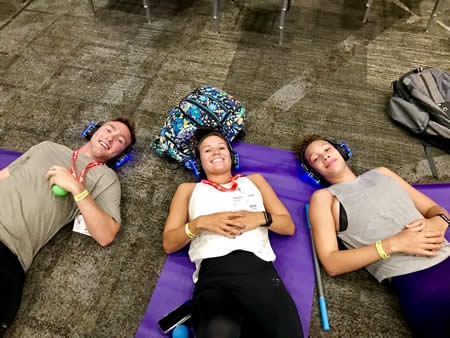
Stephen F. Austin State University juniors Garrett Plumlee of Longview, Valentina Stinchfield of Tyler and Breanna Lemons of Hawkins practice meditation at a fitness conference before the COVID-19 pandemic. They are enrolled in the inaugural year of a new academic pathway that helps students in Tyler Junior College’s wellness and exercise program complete a four-year Bachelor of Science in kinesiology with a concentration in exercise science at SFA. Photo courtesy of Anne Provencher
August 13, 2020 - Students enrolled in Tyler Junior College’s wellness and exercise program now have a way to complete a four-year Bachelor of Science in kinesiology with a concentration in exercise science at Stephen F. Austin State University in Nacogdoches.
The new pathway helps TJC students transfer their credits based on the Workforce Education Course Manual to SFA, which recently switched to the Texas Common Course Numbering System.
“This allows more classes to be transferred into SFA, so that reduces the students’ time to graduation and it reduces their cost because we’ve already agreed that those certain courses are going to transfer in,” said Dr. Jay Thornton, chair of SFA’s Department of Kinesiology and Health Science. “Some of those transfer in as junior- and senior-level courses.”
Anne Provencher, chair of TJC’s Department of Wellness and Exercise Science, said there’s another benefit to the pathway.
“It provides an easy, step-by-step plan with classes sequenced to ensure success at the next level,” she said. “Some students may have to work on the side or may be the first in their family to attend college or may face other issues. They may need a more gradual entry to the university level.”
The TJC program incorporates a lot of hands-on training to help students more easily transition to university-level labs and understand their future job opportunities, Provencher added.
“Students must complete a practicum at TJC, which gives them an opportunity to work with community businesses as interns, get a feel for the industry and network with those who will be hiring when they graduate,” she said. “We want to prepare them for the university level and show them what’s available to them in the industry once they earn their degrees and possibly while they earn their bachelor-level degrees.”
After completing two years of coursework to earn their Associate of Applied Science in wellness and exercise at TJC, students in the pathway transfer to SFA to complete their Bachelor of Science in kinesiology with a concentration in exercise science.
“Our program at TJC aligns with the Workforce Education Course Manual, so we’re coming from the workforce administration side instead of the academic side,” Provencher said. “So, for SFA to be gracious and add our courses to its second or third level is truly unique and greatly appreciated.”
Approved a year ago, the pathway is rolling out this fall despite the COVID-19 pandemic.
“As long as nothing changes, our groups are small enough that we can socially distance and complete the lab portions,” Provencher said. “And we have a hybrid approach for moving online with coursework and meeting in even smaller groups for testing if the pandemic worsens in East Texas.”
The students enrolled in the inaugural year of the program are juniors Breanna Lemons of Hawkins, Garrett Plumlee of Longview and Valentina Stinchfield of Tyler.
Lemons said the streamlined TJC-SFA pathway will keep her on track with courses she really wants to take while preparing her for a wide range of career opportunities.
“I appreciate the focused academic approach,” she said. “I don’t have to take a lot of extra, generalized courses.”
Plumlee developed an affinity for exercise science while playing sports growing up and coaching for Bishop Thomas K. Gorman Catholic School in Tyler for three years. He also was drawn to the program because of the many career opportunities it presents.
“There are several routes I can see myself going after graduation, whether I'm personally training, coaching at a high school or going the graduate assistant strength and conditioning coach path,” he said. “I can see really enjoying myself in any of those.”
Plumlee believes this pathway will open doors for students in the region.
“The TJC-SFA partnership will give students in Deep East Texas options and accessibility to a four-year degree,” he said.
Stinchfield was anxious at first about the transition from a junior college campus to a university with bigger classes, but after talking with her advisors, she’s ready for fall.
“I’m looking forward to the different ways of learning and styles of teaching,” she said.
Stinchfield played soccer from age 4 through her graduation from Whitehouse High School. She then played competitive soccer before earning her Associate of Arts in teaching at TJC.
Now she wants to focus on exercise science so she can be an effective trainer and coach.
“I want to work with people and teach them how to live healthy lives,” Stinchfield said. “I really want to start training kids when they’re young so they can develop safe, lifelong exercise habits.”
Students obtaining this degree move on to careers in exercise physiology, fitness, medicine and rehabilitation, research, and other allied health areas. The upper-level courses in SFA’s exercise science concentration help students specialize in their areas of interest, such as personal training, sports performance, athletic training and clinical exercise physiology.
This kinesiology degree also prepares students for graduate health professional degree programs to become traditional and osteopathic medical doctors, physical and occupational therapists and physician assistants.
“The Bachelor of Science in kinesiology is one of the top undergraduate degrees nationwide that physical and occupational therapists earn to obtain careers in that field,” Thornton said.
In addition to increasing enrollment at TJC and SFA, Provencher hopes the pathway will train more health and fitness professionals who can teach others safe wellness strategies based on proven information.
“These students will have true science behind them,” Provencher said. “They will know what they’re doing based on real health and safety information and not on the beauty of the market.”
For more information on this program, contact Thornton at jthornton@sfasu.edu or Provencher at apro@tjc.edu.
August 12, 2020 - According to the U.S. Environmental Protection Agency, glaciers around the world have lost significant mass since the 1970s, due in part to warming trends in global temperatures. While the concept of massive sheets of ice may seem foreign to Texans, their importance can’t be overstated.
“Glaciers hold 75% of our fresh water, and they cover 11% of the Earth’s land area — they play a lot of different roles,” said Brianna Clark, Stephen F. Austin State University environmental science graduate student in the Arthur Temple College of Forestry and Agriculture. “For example, in some countries the glacial meltwater is a source of hydroelectric power. In some alpine communities they are the sole source of drinking water.”
Given their global importance, Clark sought to shed light on current trends in glacial coverage within two U.S. national parks by performing area and volume calculations of the landforms using digital remote sensing and geographic information systems.
Clark explained that the study of glaciers, known as glaciology, has been radically expanded thanks to satellites surveying the Earth.
In 2013, NASA and the U.S. Geological Survey launched the Landsat 8 satellite, which orbits the Earth every 99 minutes and captures approximately 740 scenes of the planet each day in nine electromagnetic spectral bands.
Clark said the bands represent different portions of the electromagnetic spectrum and have wavelengths of varying size. Researchers viewing the satellite imagery online are able to add or subtract observable bands to create ratios that improve the visibility of different landforms.
“With my project, I used two ratios — the normalized difference snow index and the normalized difference glacier index,” Clark said. “There have been a lot of studies that used the normalized difference snow index, but not a lot have used the normalized difference glacier index. My project used a combination of both.”
The two parks at the center of her research, Glacier and Mount Rainier National Parks, were chosen based on their representation of two distinct geographic and climactic regions known as the Intermountain Region and the Pacific Northwest.
“Most studies have focused on the plausibility of using satellite remote sensing for measuring specific glacier parameters or measuring one specific region, but there has been a lack of research combining satellite remote sensing and climatic factors to assess the differences in deglaciation among regions,” Clark said.
To do this, Clark used satellite imagery to measure the glacial area of her study sites for the years 1985, 2000 and 2015. She then used contour lines to make digital elevation models in order to calculate the change in volume of the glaciers. In addition to the satellite imagery, Clark also compared climate trends between the two regions by measuring cumulative degrees above zero for each study year, as well as precipitation.
Dr. Daniel Unger, Kenneth Nelson Distinguished Professor of geospatial science and graduate advisor for Clark’s research, said the geospatial technology utilized by Clark is a game changer.
“Remotely sensed data allows a researcher to obtain information over a large geographic area within each image, sometimes from locations that a researcher would not physically be able to get to on the ground,” Unger said. “Given the large synoptic perspective within a Landsat image — approximately 13,200 square miles — obtaining ground information remotely can be cheaper than physically visiting each location. An added benefit is the digital data can be obtained over a series of dates allowing for change detection analysis, as was in the case in Brianna’s research.”
Ultimately, Clark found that within the 30-year period of the study, Glacier National Park lost 27.5% of its glacial coverage, while Mount Rainier lost only 5.7%.
“The differences in these percentages can largely be attributed to the warmer temperatures of the Intermountain Region coupled with lower amounts of snowfall compared to the Pacific Northwest,” Clark said.
She added the Earth undergoes natural cycles between warm and cool temperatures, but this typically takes place over a much longer time scale than currently being experienced.
“Glaciers melting isn’t always something to be alarmed about because it’s something that naturally occurs,” Clark said. “But given the rate at which they are decreasing, we are to some extent contributing to it through anthropogenic climate change.”
According to the U.S. Geological Survey, records of deglaciation in Glacier National Park was observed as early as 1914, corresponding with the Industrial Revolution and the beginning of global warming trends.
“In 2003, two researchers modeled glacial change within the park, simulating increases in atmospheric carbon dioxide concentrations and a 2-to-3-degree Celsius rise in temperature by 2050,” Clark said. “Based on this simulation, it is predicted that between 2030 and 2080, many of Glacier National Park’s remaining glaciers will disappear.”
As glacial research continues, Clark’s work will provide a valuable record of the state of these glaciers, as well as how geospatial technologies can facilitate similar research in the future.
Stephen F. Austin State University environmental science graduate student Brianna Clark utilized satellite imagery and geospatial technology to calculate the change in glacial area within Glacier and Mount Rainier National Parks over a 30 year period. Her research found Glacier National Park lost 27.5% of its glacial coverage, while Mount Rainier lost only 5.7%. Clark said the variance of glacial loss is largely the result of the difference in temperature and precipitation between the two regions where the parks are located.
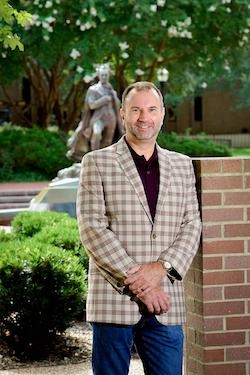 August 6, 2020 - When Fred Poston was a senior at Klein Forest High School in the Houston area, attending Stephen F. Austin State University was a good business decision.
August 6, 2020 - When Fred Poston was a senior at Klein Forest High School in the Houston area, attending Stephen F. Austin State University was a good business decision.
“I had interest in attending a private university, but when I compared the costs, SFA just made sense,” he said.
Poston’s early business acumen paid off – he earned a Bachelor of Business Administration in 1992 and soon departed the state to begin his career in the entertainment industry.
“It wasn’t a career I had been considering,” he said. “In the early ’90s, most of the people I went to school with were getting job offers and lining up jobs before they graduated. Then a recession hit in 1992, and there wasn’t a job waiting for me. So, I asked myself what I might enjoy doing and decided to just give it a shot.”
Poston worked at a coffee factory for a few weeks to make enough money to pay for his transportation to California, and then landed a job in the Dick Clark Productions mail room making $40 a day.
“It didn’t pay all the bills, but it motivated me to work hard and make sure I could support myself,” he recalled.
Poston’s next step involved work with live television shows.
“The company was doing a lot of award shows at that time,” he said. “It was a great way to learn the aspects of production for live television – you only got one chance to get it right, because everybody was watching.”
Poston learned that television production involves very long and intense working hours, so he set his sights on the networks.
“I would see network executives kind of come and go, and I had to figure out what those folks were doing,” he recalled.
Poston got his wish in 1995 when he was hired to be a part of the launch of Warner Brothers’ The WB Television Network.
“It was great ground for learning everything it takes to build a television network, and it gave me the skill set to carry forward to the next network launch, which at the time was Fox Family,” he explained.
Poston had the opportunity to launch Fox Family for the second time when it was bought by Disney and became ABC Family. Much like his earlier work in live television, Poston learned that executive work also was very intense.
“Starting a television network – or a business – is very different than working with an organization that’s already established. You have to build everything from the ground up,” he said. “An advantage for me was coming out of the College of Business at SFA. Even though it was media work, I was a good partner to the people who were creating the product, that product being the creative business of telling stories. My priority was keeping an eye on what it takes to do story-telling as a business, and ultimately getting that product to the viewers.”
More recently, Poston worked with Discovery Communications to launch The Hub, a joint venture with Hasbro, and had a hand in the launch of OWN – the Oprah Winfrey Network. Poston’s work with Discovery Communications in California eventually took him across the country for what was scheduled to be a month-long project in Florida to manage Discovery’s Latin American operations.
“That led to living in Miami for multiple years and working in Argentina, Brazil and Mexico, setting up local operations,” Poston said. “I would travel on a regular basis, meeting and hiring people to manage the regional production and operations. Managing people in other countries is an entirely different ballgame, due to the differences in languages and cultures. It definitely tested my skill sets.”
Poston again rose to the occasion when asked to oversee global operations for Discovery’s Asia-Pacific networks based in Singapore, managing operations for more than 80 channels and developing strategy for multi-purposing media.
“I was very fortunate – I was at the right place at the right time, from that first mailroom job to my first network launch,” he said. “And there was a time when my skills were used to provide change management leadership to reorganize or, in some cases, close networks. As interesting opportunities came along, I got involved, and that would lead to the next job. It was a privilege to be given these responsibilities.”
Always motivated and driven, Poston set and met the personal milestones he set for himself: a member of the Academy of Television Arts and Sciences, vice president by 30, senior vice president by 40. Now vice president for operations services for the CBS division of the ViacomCBS Corporation, Poston has played a role in the network origination of more than 100 channels in more than 40 countries and in 20 languages. Prior to the COVID-19 pandemic, he commuted to work each week in Los Angeles from his home in San Marcos.
“It’s been an incredible journey,” he said. “I’ve thoroughly enjoyed the things I’ve been involved with and the many talented people and projects I have had the fortune to be a part of, while always making it a priority to make a difference and give back in everything I do.”
This desire to make a difference led Poston to serve for 10 years on the board of directors for the Alliance for Housing and Healing, an organization that provides housing, food and healthcare for individuals in need in Los Angeles County.
Poston said he was honored to be invited to provide the virtual commencement address for SFA in August and will deliver a positive message to the graduation candidates.
“My industry’s business has been about telling stories, and I am fortunate to have this opportunity to share my life story,” he said. “Things have changed for each graduate, but each one should realize and think to themselves, ‘I haven’t changed.’ They’ve completed their college degrees, and regardless of where they did that, they can decide how they will narrate and use that story to write their next chapters. We are definitely living in different, trying times – and we have an opportunity to choose how we will continue.”
The ceremony will be available via the SFA website beginning at 6 p.m. August 14. More than 400 students are candidates for graduation, including five doctoral candidates, 114 master’s degree candidates and 325 bachelor’s candidates. For more information, visit sfasu.edu/commencement.
July 30, 2020 - Registration is underway for fall classes in the Music Preparatory Division of the Stephen F. Austin State University School of Music.
The fall roster for youth includes lessons in piano, violin, cello, viola, voice, Music Theory Adventures and Piney Woods Youth Orchestra, among many others. Lessons may be available for other instruments upon request. Lessons begin Aug. 17. Music Prep also offers programs for adults in piano and strings.
As the world continues to struggle with the economic and emotional effects of a worldwide pandemic, music remains one of the best coping mechanisms for stress and uncertainty, according to Alba Madrid, the new director of Music Prep who took over the division in June.
“We understand that music provides an outlet to express a wide range of emotions which ultimately helps to enrich our lives in a number of ways,” Madrid said. “Children have the need to connect now more than ever, and what better way to connect with others than through music. I have witnessed firsthand, through my many years of teaching, the healthy relationships our students have with their friends in their music community. They share the same passion, interests and values.”
Because of the economic effects of COVID-19, lower tuition fees for private lessons and other programs will be offered this fall. Scholarships are available to students based on need and commitment.
“We are working to expand our scholarship funds through grants, donations and sponsorships to help families that have been negatively impacted by the pandemic,” Madrid said. Deadline to apply for a scholarship is Aug. 15.
Madrid said appropriate Centers for Disease Control and Prevention safety protocols, including wearing face coverings, maintaining social distancing and following sanitizing procedures, will be followed. Students, parents and teachers will have the flexibility to decide on lesson format: face to face, virtual or a hybrid structure.
A new String Project will be piloted in the spring. The nine public school districts with in Nacogdoches County and some surrounding districts will be invited to participate. String Project students will have the opportunity to learn to play a stringed instrument at a low tuition cost as part of an after school activity. The project will be grant and community funded.
Registration for private and group instruction can be completed online at sfamusicprep.com or by calling (936) 468-1291. Prices range from $20 to $180 per month, depending on frequency, type of lesson and lesson length.
The Music Prep House is located at 3028 Raguet St. Office hours are 1pm to 5pm Monday through Friday. Madrid can also be reached via email at madrida@sfasu.edu or musicprep@sfasu.edu. Parents can also find program information on Facebook and Instagram.
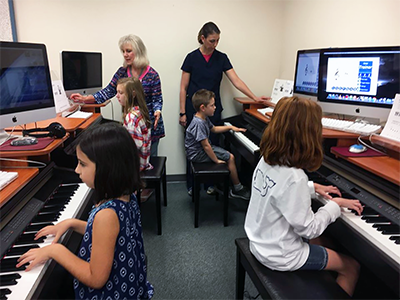
Fall class registration for music instruction through SFA’s Music Preparatory Division is underway. Lessons begin Aug. 17.
July 29, 2020 - Keeping the safety of their fellow students in mind when the campus opens this fall, five interior design seniors at Stephen F. Austin State University spent the summer working as interns for SFA’s Office of Institutional Effectiveness to collect data on classrooms and design safe learning environments for their classmates.
On June 8, Miriam Amador of Lufkin, April Cooper of Huntington, Osiel Mireles and Cristel Perez of Houston, and Brooke Ward of Dallas were tasked with taking measurements, inventorying and photographing all furniture and technological equipment, and documenting elements ranging from electrical outlets to floor, baseboard, wall and ceiling materials for nearly 400 rooms across campus, including auditoriums, gyms and laboratories.
“They had to assess every space that can possibly be used to teach a class,” said Sally Ann Swearingen, associate professor and internship coordinator for the interior design program at SFA.
The students are working through all their data to create floor plans for each SFA building to comply with Centers for Disease Control and Prevention guidelines by the first week of August. They’re also compiling spreadsheets with information to help faculty members know how many students are allowed in each learning space and how to arrange the furniture and technology in those spaces to meet physical distancing requirements.
The students’ finished floor plans, along with their proposed physical distancing furniture plans and occupant loads for each room and lab, will be posted on the Office of Institutional Effectiveness website. All faculty and staff will have full access to this site.
“This will be a great resource many people will be able to utilize even after the pandemic ends,” Swearingen said. “Everybody will have access to it, so faculty and staff, department chairs and deans will all know how each classroom should look.”
In return for their efforts, the interior design seniors are receiving a small stipend and credit for their interior design internship course.
Swearingen directed the students to approach this assignment as if they were completing a job for an interior design client.
“I believe in looking at a job to see how you can make others’ lives better,” Swearingen said. “This is a great way to illustrate to these students how to be resourceful and utilize their creative skills to assist their firm or client.”
The client for this project is John Calahan, director of the Office of Institutional Effectiveness at SFA.
“This has been a great group of students to work with,” Calahan said. “Their efforts are critical to the safe opening of the university in the fall. The data, analysis and plans they’ve developed set a new standard for information management regarding our academic spaces and will inform future decisions for the university.”
All five students have different strengths that contribute to the team, Cooper said.
“We have five different perspectives, so we’ve been able to eliminate any gaps in our COVID plan,” she said. “We were able to correct each other and prevent each other from missing something.”
One of the first needed strengths was proficiency in the Microsoft Teams application, which Amador provided. She helped team members use the tool to connect with each other and exchange large quantities of data, including photos of every piece of furniture and technological equipment encountered in each classroom. She also used the app to ensure her teammates uploaded complete information.
“Using Teams was key because we’re not all in the same location and we’re not online at the same time,” Amador said.
Amador and Ward led efforts to take the physical measurements of each room.
“We noted every door, every small nook, all the windows and electrical outlets,” Ward said. “We made sure electrical plans were accurate for the electrical team to come in later and create Zoom rooms.”
Cooper assessed the furniture in each room to help determine how it should be arranged and occupied for proper physical distancing among students in the fall.
Amador, Cooper and Ward uploaded digital copies of their measurements, drawings and notes in Microsoft Teams so Mireles and Perez could use computer-aided design software called AutoCAD to merge the information into floor plans for each room.
“We made the plans really simple to understand, even for someone who doesn’t know how to read floor plans,” Mireles said.
The interior design seniors have had to juggle jobs, other classes and commutes from out of town to complete this assignment. Cooper commutes from Huntington, Mireles commutes from Houston and Perez contributes remotely from Houston, where she’s working and taking two other courses.
Though the students knew each other from their junior year classes, this opportunity gave them the chance to learn from each other.
“It was great being able to work as a team even when we can’t be physically together,” Perez said. “That’s the challenge of COVID.”
Mireles and Perez transferred to SFA through the university’s interior design partnership with Houston Community College. They used Zoom to attend classes from Houston even before the pandemic.
“When we were in the Zoom classes, we all would see each other, but Cristel and I never would communicate with April or Brooke or Miriam,” Mireles said. “But this fall, I’ll feel comfortable texting them if I need help and vice versa.”
Swearingen said learning how to work with team members who have different schedules and live in different locations is good preparation for when these students graduate and begin working for global firms with offices in a variety of time zones.
“There are so many firms that have an office in London and another in Houston and another in New York,” she said. “We’re training them that this is how you work together.”
Swearingen added, “This group of students has done really well to brainstorm, talk among each other and work through issues and double-check each other. It takes a team effort.”
Perez said team members have been able to exchange different tips and tricks they picked up on their respective campuses.
“Osiel and I learned AutoCAD tricks from our HCC professors, while April, Brooke and Miriam had their own tricks from SFA professors,” Perez said. “We’ve picked the best of both worlds to apply in future projects.”
This internship also gives the interior design seniors experience — the ability to create COVID-19 plans for offices and workspaces — that more businesses will need as employees return to work during the pandemic.
“At the beginning, I just considered this a regular internship, but now, toward the end of it, I’m very proud of us,” Mireles said. “I feel like this is special for us because it reflects what’s going on in the real world. We can show potential employers our portfolio and tell them how we put our COVID plan together, and I think they’re going to be really impressed.”
The seniors said their fellow students should feel safer knowing SFA is meticulously following CDC guidelines while making preparations for the fall.
“We know what’s going on; we’re seeing it with our own eyes. We've been working many hours a week for the past two months to complete the project,” Ward said.
Perez added, “And we’re students, so other students know we care because we’re also attending classes here. We want to make it safe not just for us but for others, too.”
For more information on SFA’s reopening plans, visit sfasu.edu/fall2020.
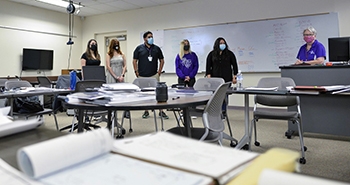
Sally Ann Swearingen, far right, associate professor of interior design at Stephen F. Austin State University, assembled a team of five interior design seniors to help ensure safe learning environments for their fellow students when SFA reopens this fall. From left, Brooke Ward of Dallas, Cristel Perez and Osiel Mireles of Houston, April Cooper of Huntington and Miriam Amador of Lufkin spent the summer taking measurements, inventorying furniture and technological equipment, and documenting elements ranging from electrical outlets to floor, baseboard, wall and ceiling materials for nearly 400 rooms across campus to produce detailed floor plans for each SFA department and school. Their floor plans indicate how to arrange furniture to help ensure compliance with Centers for Disease Control and Prevention physical distancing guidelines. They also produced spreadsheets with data to guide faculty members on the number of students allowed in each learning environment. Photo by Robin Johnson
By Jo Gilmore, marketing communications specialist at Stephen F. Austin State University.
July 28, 2020 Nacogdoches — Two separate virtual programs will allow Stephen F. Austin State University students and their parents to experience firsthand the academic rigors and student engagement that make the Lumberjack experience unique among institutions of higher education.
The two programs, Virtual Saturday and the Lumberjack Family Experience, will provide parents the opportunity to engage in informative livestream sessions with campus faculty and staff and have their questions answered about SFA’s programs and instruction.
“The objective of our virtual programs is not only to provide parents a deeper look into their own students’ experiences in the classroom and on campus, but also to provide an outlet for parents to get the answers they need as we approach the fall semester,” said Erma Nieto Brecht, SFA’s executive director of enrollment management. “We want parents to understand that, regardless if courses are delivered face-to-face or through distance-learning, their students will still be receiving the quality SFA experience they expect, no matter how they choose to build their schedule. And there is no better way to understand that than to experience it firsthand.”
Virtual Saturday
Free to any interested party, Virtual Saturday is intended to give parents and their students an immersive look at a livestream classroom setting. The 50-minute Zoom session will mirror that of an actual full Zoom class.
“We know parents have a lot of questions, and we think the best way to show them what their child’s class will be like is to let them join one,” said Dr. Joyce Johnston, associate dean in the College of Liberal and Applied Arts and the director of SFA’s Division of Multidisciplinary Programs. “We want to emphasize that however faculty members deliver their classes, students’ educational experiences are second to none. Their faculty members are supported by an outstanding team in the Center for Teaching and Learning who provide us training, innovation and technological support to help ensure high-quality distance education for all Lumberjacks.”
Those interested in participating may choose from among six 50-minute Zoom classes conducted by faculty members from each of SFA’s six colleges.
“Our hope is for family members to come away with a greater understanding of how much our faculty members care about our students,” Johnston said. “We hope they experience what their students will — that distance learning can be dynamic, engaging, innovative and enjoyable. Our faculty and our CTL constantly work to improve the students’ experience in the classroom, even the virtual one. Parents who choose to send their child to SFA can rest assured that faculty members will connect with and support all students.”
Understanding not everyone may possess the necessary technology to attend, Virtual Saturday classes will be recorded and posted online at a future date.
Seven Virtual Saturday sessions will be held Saturday, August 1 — three at 10 a.m., three at 11 a.m. and one at noon.
To register for a Virtual Saturday session, visit sfasu.edu/info-for/parents/virtual-saturday.
Lumberjack Family Experience
Hosted by SFA’s Office of Orientation and Transition Programs, the Lumberjack Family Experience offers parents several opportunities to connect with campus representatives from the comfort of their own home.
The Lumberjack Family Experience focuses on three main areas: student engagement, safety and academics. It is designed to allow parents and students to learn about the entire university experience.
Parents, guardians and family members of an incoming student for fall 2020 are invited to attend. During the event, university representatives will provide information and answer questions regarding the upcoming in-person Jack Camp Orientation, and there also will be a mock virtual classroom experience.
The Lumberjack Family Experience is scheduled for 6:30 to 7:30 p.m. Wednesday, August 5.
To register, visit sfasu.edu/orientation/first-year.









